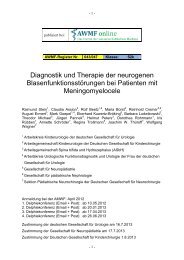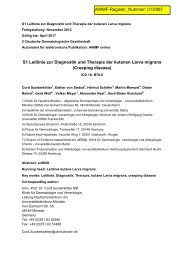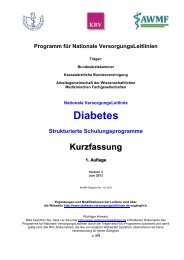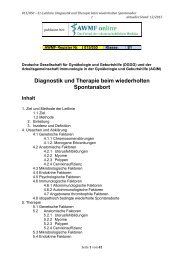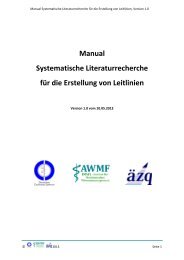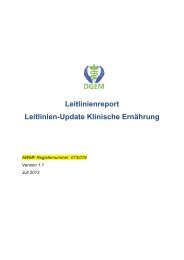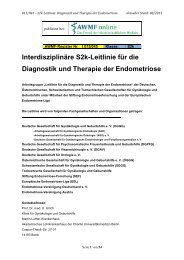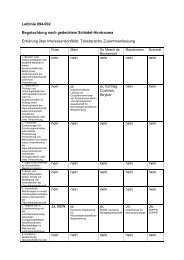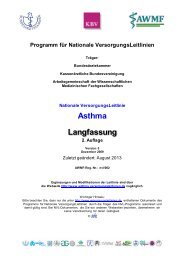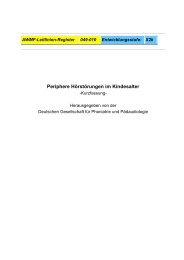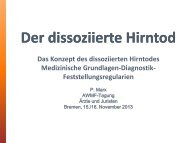Lokaltherapie chronischer Wunden bei Patienten mit den ... - AWMF
Lokaltherapie chronischer Wunden bei Patienten mit den ... - AWMF
Lokaltherapie chronischer Wunden bei Patienten mit den ... - AWMF
Sie wollen auch ein ePaper? Erhöhen Sie die Reichweite Ihrer Titel.
YUMPU macht aus Druck-PDFs automatisch weboptimierte ePaper, die Google liebt.
S3-Leitlinie 091-001 „<strong>Lokaltherapie</strong> <strong>chronischer</strong> <strong>Wun<strong>den</strong></strong> <strong>bei</strong> <strong>den</strong> Risiken CVI, PAVK und Diabetes mellitus“<br />
301. Veves A, Sheehan P, Pham HT. A randomized, controlled trial of Promogran (a<br />
collagen/oxidized regenerated cellulose dressing) vs standard treatment in the management of<br />
diabetic foot ulcers. Archives of surgery (Chicago, Ill : 1960). 2002;137(7):822-7. Epub 2002/07/03.<br />
302. Barber C, Watt A, Pham C, Maddern G, Penington A, Mutimer K, et al. Bioengineered skin<br />
substitutes for the management of wounds: a systematic review. Report. 2006:118.<br />
303. Donaghue VM, Chrzan JS, Rosenblum BI, Giurini JM, Habershaw GM, Veves A. Evaluation of a<br />
collagen-alginate wound dressing in the management of diabetic foot ulcers. Adv Wound Care.<br />
1998;11(3):114-9. Epub 1998/09/08.<br />
304. Abbruzzese L, Rizzo L, Fanelli G, Tedeschi A, Scatena A, Goretti C, et al. Effectiveness and<br />
safety of a novel gel dressing in the management of neuropathic leg ulcers in diabetic patients: a<br />
prospective double-blind randomized trial. International Journal of Lower Extre<strong>mit</strong>y Wounds.<br />
2009;8(3):134-40.<br />
305. Steed DL, Webster MW, Ricotta JJ, Luterman A, Brown S, Comerota AJ, et al. Clinical<br />
evaluation of recombinant human platelet-derived growth factor for the treatment of lower<br />
extre<strong>mit</strong>y diabetic ulcers. Journal of Vascular Surgery. 1995;21(1):71-81.<br />
306. Robson MC, Payne WG, Garner WL, Biundo J, Giacalone VF, Cooper DM, et al. Integrating the<br />
results of phase IV (post-marketing) clinical trial with four previous trials reinforces the position that<br />
Regranex (becaplermin) gel 0.01% is an effective adjunct to the treatment of diabetic foot ulcer. J<br />
Appl Res. 2005;5:35-45.<br />
307. Buchberger B, Follmann M, Freyer D, Huppertz H, Ehm A, Wasem J. The importance of<br />
growth factors for the treatment of chronic wounds in the case of diabetic foot ulcers (Structured<br />
abstract). Cologne: German Agency for Health Technology Assessment at the German Institute for<br />
Medical Documentation and Information (DAHTA DIMDI), 2010.<br />
308. Buchberger B, Follmann M, Freyer D, Huppertz H, Ehm A, Wasem J. The importance of<br />
growth factors for the treatment of chronic wounds in the case of diabetic foot ulcers. GMS Health<br />
Technol Assess. 2010;6:Doc12.<br />
309. Wieman TJ. Efficacy and safety of recombinant human platelet-derived growth factor-BB<br />
(becaplermin) in patients with chronic venous ulcers: a pilot study. Wounds: A Compendium of<br />
Clinical Research and Practice. 2003;15(8):257-64.<br />
310. Janssen Cilag Gmb H. Rote Hand Brief zu Regranex (Becaplermin): Jannsen Cilag GmbH; 2010.<br />
311. Wenzel J, Gerdsen R, Phillipp-Dormston W, Bieber T, Uerlich M. Topical treatment of<br />
pyoderma gangraenosum. Dermatology. 2002;205(3):221-3.<br />
312. Wysocki AB, Staiano-Coico L, Grinnell F. Wound fluid from chronic leg ulcers contains<br />
elevated levels of metalloproteinases MMP-2 and MMP-9. JInvest Dermatol. 1993;101(1):64-8.<br />
313. Halcon L, Milkus K. Staphylococcus aureus and wounds: a review of tea tree oil as a promising<br />
antimicrobial. AmJInfectControl. 2004;32(7):402-8.<br />
314. Gloor M, Hauth A, Gehring W. O/W emulsions compromise the stratum corneum barrier and<br />
improve drug penetration. Pharmazie. 2003;58(10):709-15.<br />
315. Falanga V. Care of venous leg ulcers. OstomyWoundManage. 1999;45(1A Suppl):33S-43S.<br />
316. Schuren J, Becker A, Sibbald RG. A liquid film-forming acrylate for peri-wound protection: a<br />
systematic review and meta-analysis (3M Cavilon no-sting barrier film). International Wound Journal.<br />
2005;2(3):230-8.<br />
317. Cameron J, Hoffman D, Wilson J, Cherry G. Comparison of two peri-wound skin protectants in<br />
venous leg ulcers: a randomised controlled trial. JWound Care. 2005;14(5):233-6.<br />
318. Rolstad BS, Borchert K, Magnan S, Scheel N. A comparison of an alcohol-based and a<br />
siloxanebased peri-wound skin protectant. J Wound Care. 1994;3(8):367-8.<br />
319. Neander KD, Hesse F. The protective effects of a new preparation on wound edges. JWound<br />
Care. 2003;12(10):369-71.<br />
320. Dunning G. Emollients: application of topical treatments to the skin. BrJNurs.<br />
2007;16(21):1342-5.<br />
321. Korner A, Dinten-Schmid B, Stoffel L, Hirter K, Kappeli S. [Skin care and skin protection in<br />
preterm babies]. Pflege. 2009;22(4):266-76.<br />
Seite 269 von 279 aktueller Stand: 12.06.2012




